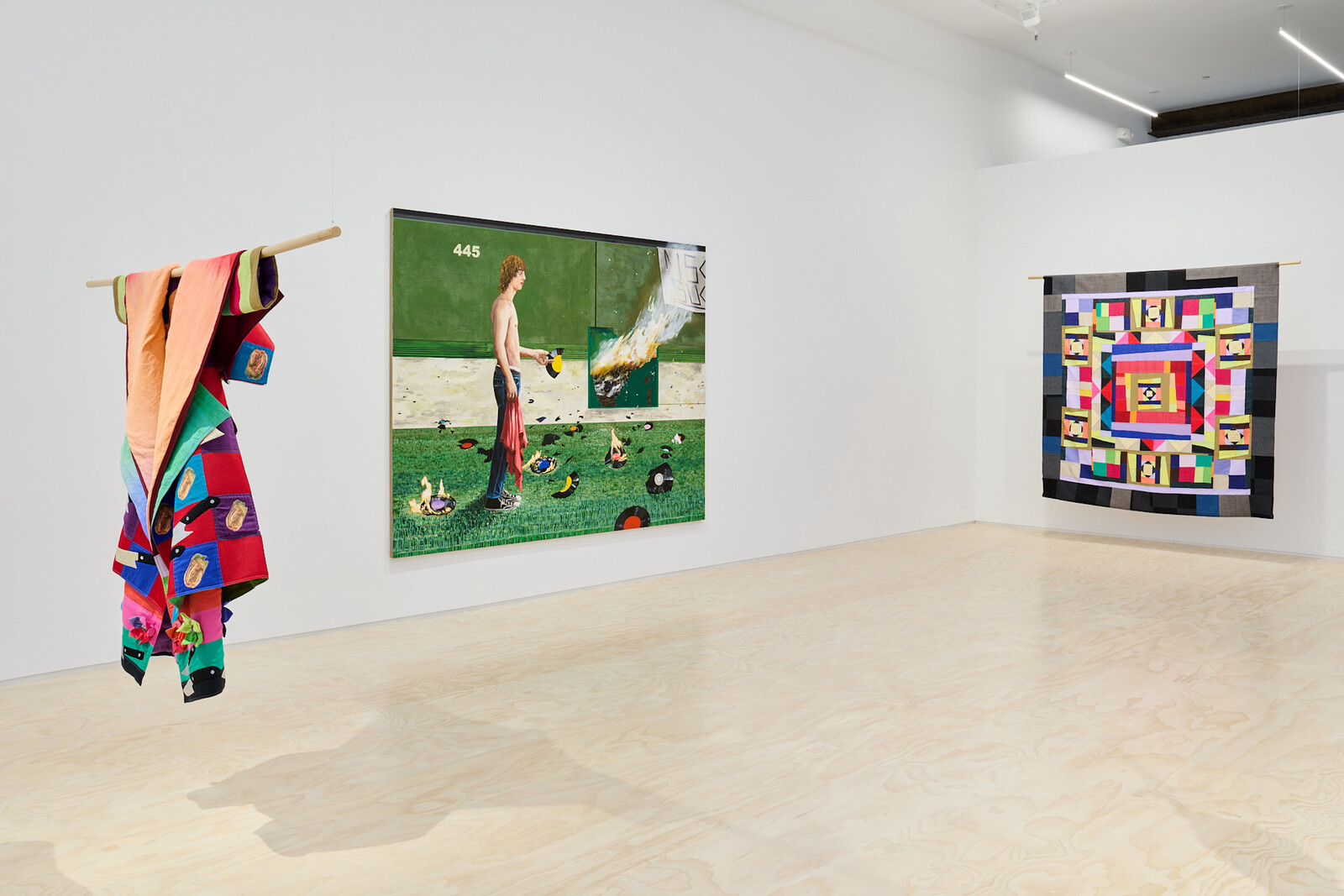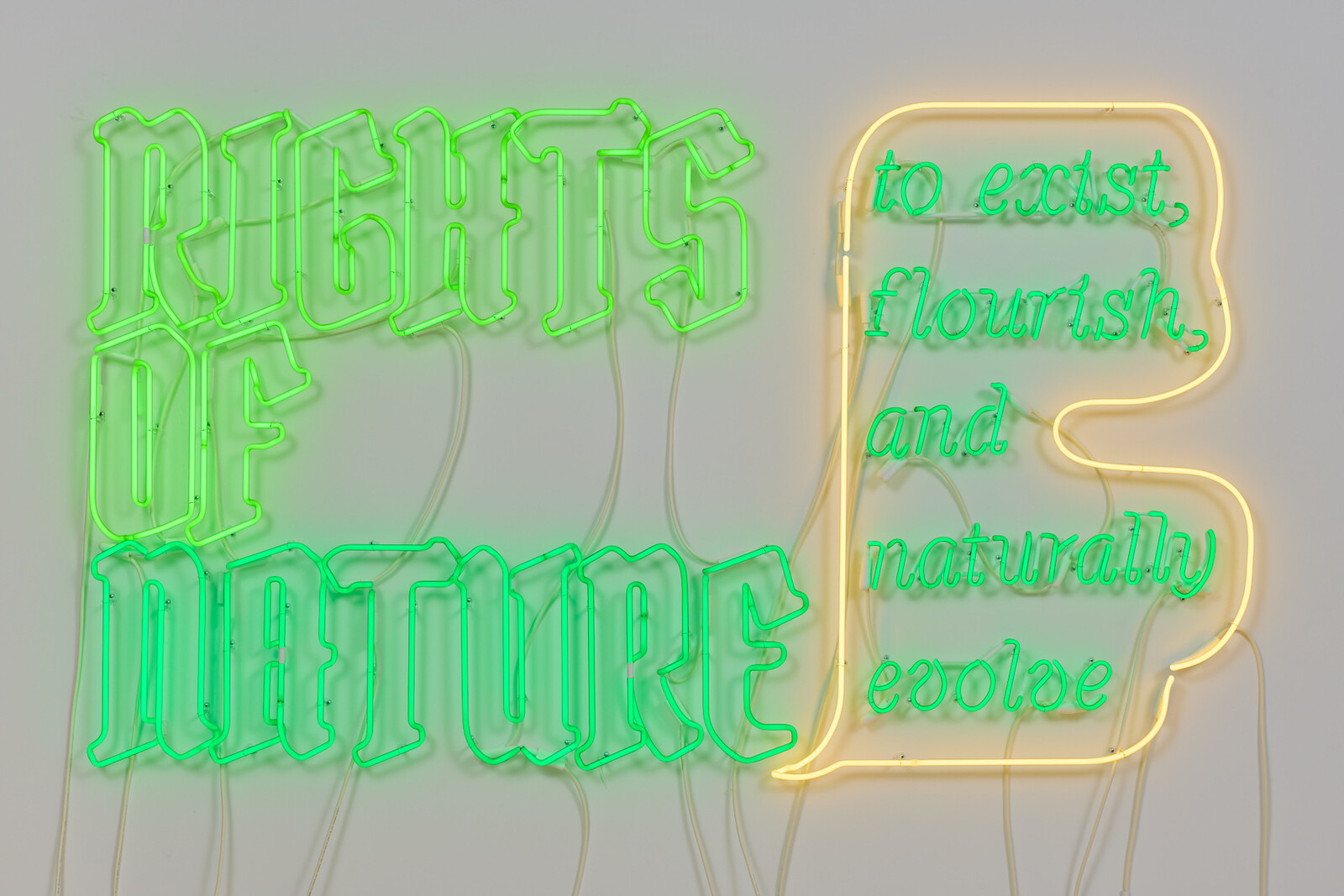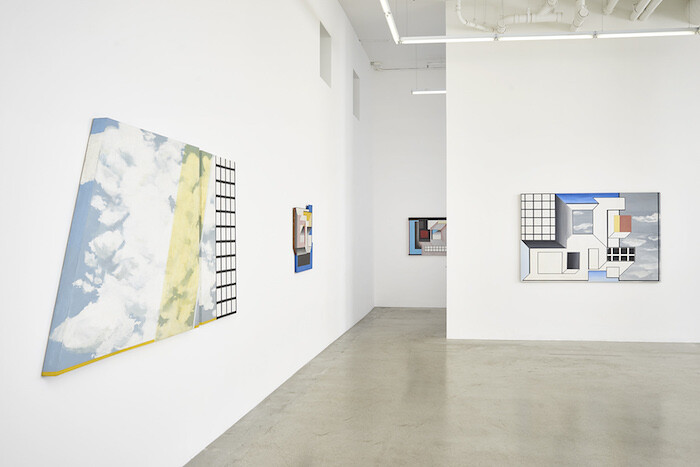Categories
Subjects
Authors
Artists
Venues
Locations
Calendar
Filter
Done
June 28, 2022 – Review
Hernan Bas & Zadie Xa’s “House Spirits”
Danica Sachs

There’s a spot in the two-person exhibition “House Spirits” from which Hernan Bas’s large-scale painting Disco Demolition Night (all works 2022) appears framed by Zadie Xa’s shamanic robe Kimchi rites, kitchen rituals, hanging near the front of the gallery, and her kaleidoscopic constellation in stitched linen-and-denim, Seven full moons, on the back wall. In this sightline, the artists seem an unlikely pairing: the content and references of Xa’s fabric works draw on her Korean heritage while Bas’s acrylic paintings are rooted in white American pop culture. In bringing these two artists into dialogue, however, this exhibition foregrounds the way each traffics in a kind of visual folklore. The tension between the former’s new, hybrid identities and the latter’s melancholy depictions of the demise of a monolithic culture reflects changing social dynamics.
Two of Xa’s brightly colored robes hang opposite each other, suspended from the ceiling. The open folds on the front of Princess Bari fall in concentric half circles, made of linen hand-dyed in shades of coral, chartreuse, and sky blue, the hues seeping together to create a riotous sunset. The back is festooned with stitched knives and a cascade of rainbow ribbons running down the back, each ending with …
April 8, 2022 – Review
Andrea Bowers’s “Can the world mend in this body?”
Brian Karl

Andrea Bowers’s solo show at Jessica Silverman is marked by the artist’s signature combination of directness and nuance. Rooted in eco-feminist engagement and employing a wide range of media—neon signs, drawings on recycled materials, and video documentary—her deftly radical work calls attention to environmental degradation caused by patriarchal systems.
Bowers’s wall-mounted sculpture Rights of Nature I (2022) glows at passersby through the gallery’s street-level storefront window. Green neon tubing, styled in antique Gothic font, evokes legal documents while limning the piece’s title phrase. This in turn seems to emit a yellow speech bubble framing the words “to exist, flourish, and naturally evolve” in a contrasting font. This work builds on the use of neon by an earlier generation of artists—Deborah Kass and Bruce Nauman among them—as a communicative medium for political commentary, while continuing to play on and against its conventional employment in commercial signage. Though less dynamic than some of Bowers’s previous witty and sharply political slogans in flashing multicolor lights, it is among her most substantial: a heartfelt and lucid declaration that the Earth and other living creatures should be afforded the same rights, ethical treatments, and legal protections as humans.
Within the gallery, a sister piece is …
April 13, 2018 – Review
Matthew Angelo Harrison’s “Prototypes of Dark Silhouettes”
Jeanne Gerrity

In an early scene in the recent blockbuster hit Black Panther, the black supervillain Erik Killmonger disputes the narrative spewed to him by a supercilious white curator regarding an African artifact on view in the “Museum of Great Britain,” asserting instead that it is a spoil of war from the (fictitious) country Wakanda. Immediately following their verbal exchange, she drops dead from poisoned coffee, and he repossesses the pillaged object in an elaborate heist. This example from popular culture demonstrates that the need to address the complicity of western museums in colonialist narratives has reached beyond the confines of the art world. The complicated politics of museum display are one of several interconnected issues—including commodification and authenticity, the role of industry and labor in cultural production, and black identity—that Detroit-based Matthew Angelo Harrison addresses in his first solo commercial gallery exhibition.
Twelve sculptures of varying heights comprise “Prototypes of Dark Silhouettes” at Jessica Silverman Gallery. Mounted on minimalist pedestals made of anodized aluminum legs and acrylic tops, tinted resin blocks that evoke the translucent geometric forms of the Light and Space movement encase what appear to be African art objects. The figures, heads, and masks are visible through varying levels of …
October 28, 2016 – Review
Suzanne Blank Redstone’s “1960s Portal Paintings”
Leigh Markopoulos

Fifty years after painting the earliest work in this exhibition, Suzanne Blank Redstone has her first solo show. The name may be unfamiliar, but her work at first glance appears to participate in a recognizably twentieth-century art-historical dialogue. Featuring primary-colored geometric forms and grids, her compositions instantly evoke Piet Mondrian, at the same time hinting at a venerable tradition of European pre-war geometric abstraction of the sort practiced by Jean Hélion. While her experiments with illusion and perspective take part in an even older lineage, there’s also a nod to Surrealism evoked by incongruous René Magritte-like clouds occasionally softening the otherwise hard-edge constructions.
Despite these superficial resemblances, the works in this show reflect less about art history than the artist’s own triangulation of space and color. Seven of the ten paintings and all of the drawings on display at Jessica Silverman Gallery derive from “Portal,” a series of 38 paintings made between 1966 and 1969, each accompanied by between three and ten preparatory drawings. In addition to the intentionally restricted red, blue, and yellow palette—relieved by black, white, and a grey mixed from the other pigments—Redstone’s formal vocabulary encompasses rectilinear shapes and grids aligned exclusively along 45 and 90 degree axes.
Setting …